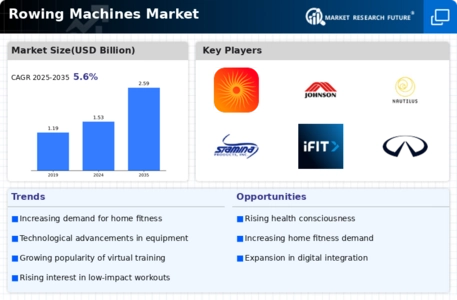Market Analysis
In-depth Analysis of Rowing Machines Market Industry Landscape
The market dynamics pertaining to rowing machines are a complex phenomenon that are shaped by a multitude of factors that impact customer choices, industry trends, and the overall growth trajectory. A primary trend is consumers' growing recognition of the significance of fitness and well-being. The popularity of healthy lifestyles is driving up demand for home exercise equipment, such as rowing machines. For those looking for a flexible and effective form of training, rowing machines offer full-body exercises that are both convenient and effective. The rowing machines market is shaped in large part by technological developments. The user experience is improved by the incorporation of intelligent elements including interactive training plans, real-time performance tracking, and linked fitness applications. Rowing machines with technology-driven features are attracting more and more customers because they offer a connected and engaging training experience in addition to a physical workout. This technological integration draws in tech-savvy customers and supports the growth of the sector as a whole. Rowing machine sales have been greatly influenced by the global movement in customer preferences toward at-home workout options, which has been hastened by the COVID-19 epidemic and other events. Rowing machines are becoming more and more popular as more people want to work out at home since they provide a cardiovascular exercise that is both low-impact and efficient. It is anticipated that this trend will continue, increasing demand for small, home-use rowing machines that are easy to use and compact. The emphasis on ergonomics and user-friendly design also affects market dynamics. Customers look for rowing machines that offer comfort. In response, manufacturers are improving the whole user experience by adding adjustable resistance levels, cozy chairs, and ergonomic designs. The emphasis on user-friendly features addresses the changing demands and tastes of customers, which influences market dynamics. Market dynamics are influenced by competitive pricing and the availability of rowing machines at a range of price points. Rowing machines are an affordable option for a variety of consumers when compared to other home training equipment. In addition, a range of models at varying price points have entered the market, giving customers the option to select according to their needs and budget. This range of prices draws in more customers and increases market competitiveness. Market dynamics in the rowing machine industry are being impacted by awareness of sustainability and the impact on the environment. To meet the increasing demand for goods that are environmentally sensitive, manufacturers are using energy-efficient features, sustainable production methods, and eco-friendly materials. Customers are becoming more likely to buy rowing machines that are consistent with their sustainability ideals, which is changing the market dynamics and pushing industry participants to use more environmentally friendly methods. By educating potential customers about the advantages of rowing machines, consumer education and awareness initiatives also influence the dynamics of the market. Demand for the product rises as people become more aware of the benefits rowing offers for cardiovascular health, muscular tone, and general fitness. In order to influence customer preferences and shape market dynamics, manufacturers and fitness professionals are essential in teaching consumers about the many features, training regimens, and health benefits connected with rowing machines.
Rowing machines' market exposure and accessibility are influenced by retail strategy and distribution networks. One factor in the broad acceptance of these fitness gadgets is their availability in regular retail stores as well as online. The comfort of doorstep delivery and the accessibility of online shopping combine to further magnify market dynamics by reaching a worldwide consumer base. The growing emphasis on fitness, technology developments, the popularity of at-home workouts, ergonomic designs, competitive pricing, sustainability considerations, consumer education, and other factors are influencing the rowing machine market dynamics. The market for rowing machines is anticipated to continue to change as demand for at-home workout options rises and industry participants adjust to these dynamics in order to satisfy the varied demands and inclinations of customers who are health-conscious.


















Leave a Comment